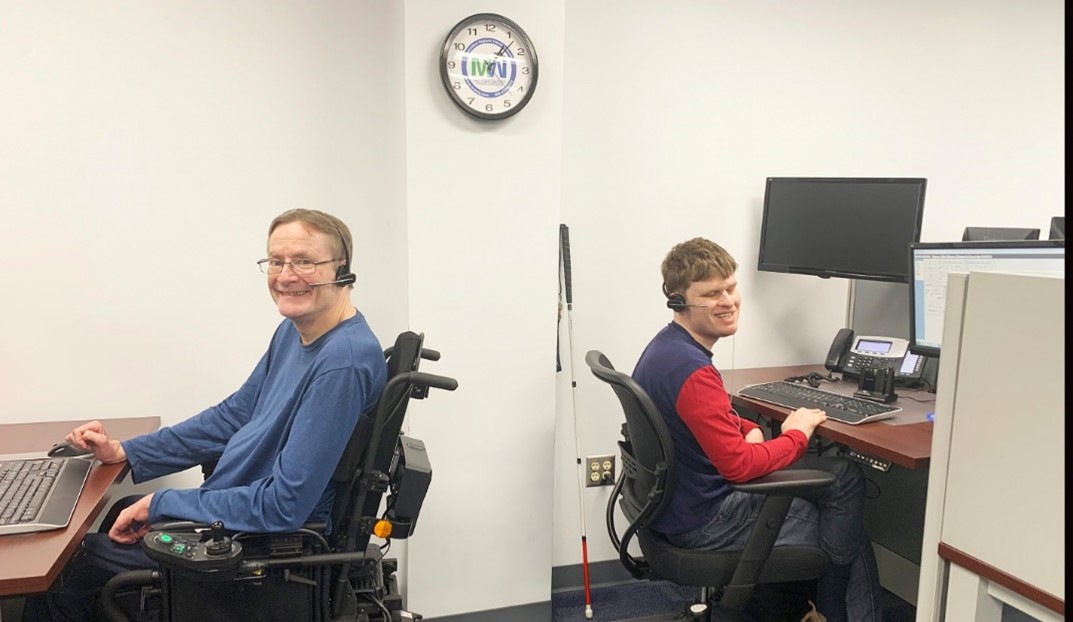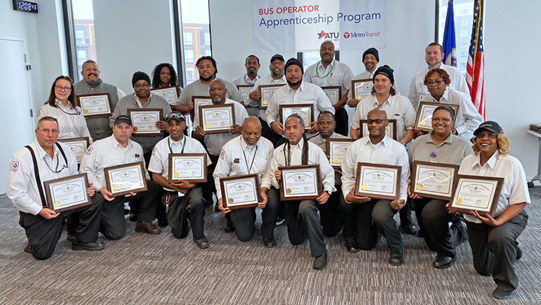Guest Blogger—David Stephen is the senior communications specialist for the International Transportation Learning Center (ITLC) and leads the development of #ConnectingMyCommuity, the National Transit Frontline Worker Toolkit and Campaign. Learn more about the toolkit at transitworkforce.org/connect, or contact him at dstephen@transportcenter.org.
Guest Blogger—Shayna Gleason is a research associate with ITLC. She conducts varied research projects, including research related to the inclusion of older adults and people with disabilities in the transit workforce. You can contact her at sgleason@transportcenter.org.
Guest Blogger—Karitsa Holdzkom is the senior policy analyst for ITLC and heads initiatives around apprenticeship and mentorship, including the American Transit Training and Apprenticeship Innovators Network (ATTAIN). Learn more at https://www.transitworkforce.org/attain/ or contact her at kholdzkom@transportcenter.org.
Across the United States transit agencies of all sizes face the challenge of recruiting and retaining frontline workers. Potential employees from some demographic groups may assume that working in transit is out of reach, but this doesn’t have to be true. This blog will discuss three recruitment and retention strategies to address transit’s workforce shortage.
The Transit Worker Recruitment Toolkit
To help support local transit efforts, the Transit Workforce Center (TWC) co-created a frontline transit worker recruitment toolkit called #ConnectingMyCommunity with the Federal Transit Administration (FTA) and industry, labor, and community partners nationwide. The toolkit contains materials that agencies, labor unions, and community partners can use to design effective recruitment outreach with templates, themes, and approaches that can guide effective outreach to targeted demographics, including older workers and those with disabilities. Among those approaches, themes like “My Community Works Because I Work” and “Serving My Community” are among the most popular in the customizable templates available at www.transitworkforce.org/connect because of their ability to resonate with those who find the concept of community service work important and attractive. The toolkit also includes sample ads from other agencies, recruitment videos, tips, and case studies for all to use and review. As the industry continues to evolve and change, the toolkit will be continually updated to provide materials and resources that stakeholders in public transit can adapt to targeted audiences as they design their recruitment efforts.
Partnerships to Promote the Inclusion of Older Workers and Workers with Disabilities
Recruitment challenges can also be addressed by thinking creatively about untapped pools of qualified job candidates, including older adults and people with disabilities, who are often overlooked as viable transit employees. Individuals from both demographic groups are already successfully employed in many transit agencies, but opportunities exist for greater inclusion.
In the overall workforce, 21% of people with disabilities are employed, compared with 65% of people without disabilities.[1] Meanwhile, 90% percent of transit agencies need help hiring frontline employees[2]. Transit’s acute need for qualified employees, coupled with the low employment rate in the disability community, suggests a tremendous opportunity for a mutual need to be met.

Credit: Courtesy of MetroWest Regional Transit Authority
Some agencies are turning to disability-serving organizations as recruitment partners. For example, MetroWest Regional Transit Authority (MWRTA) in Framingham, MA, has leveraged partnerships for more than 15 years to hire people with disabilities into various positions. Partner organizations have helped MWRTA both identify suitable employees and navigate accommodation processes.
One MWRTA employee with visual impairment reported that he enjoys being “in a position where [he] can relate to the population” he’s serving. MWRTA staff has found his lived experience to be invaluable.
With many retirements on the horizon in the transit industry, older workers often assumed to be near retirement are only sometimes recognized as a key part of the solution to the transit workforce crisis. However, many Americans need to work longer than in previous decades, and creative transit providers recognize that older workers, including newly hired ones, can help alleviate staffing challenges. Several innovative transit agencies have been proactive in this area: Cape Cod Regional Transit Authority (CCRTA) recognized a need to actively recruit older transit drivers, given Cape Cod’s large population of older people. As a result, CCRTA has been better able to recruit and retain older workers by offering part-time options and additional time off for medical appointments and tailoring marketing materials to emphasize that older applicants are welcome.[3]
Positive Effects of Mentorships
Several agencies have recognized that older workers offer a lifetime of experience with customer service, problem solving, driving, and other skills they can share as mentors, a new and different role for older workers that can provide them with new opportunities and persuade them to stay longer at an agency. Along with recruitment tools and strategies, it’s important not to forget about retention. Strategies that improve retention rates can provide an appreciable return on investment. Mentorship programs are becoming popular in the industry for that reason.

Credit: ATTAIN, courtesy of TWC
Mentorship provides a channel for guidance beyond technical driver training and allows experienced drivers to share the wisdom they’ve gained on the job so their mentees can thrive in their new role. In addition, mentors help drivers develop the less tangible “soft skills” necessary to succeed, like interacting with riders, providing good customer service, and dealing with the stresses of the job. Mentors also offer moral support and practical, professional advice so drivers feel confident and prepared.
Mentors might be required to conduct periodic ride-alongs or hold regular check-in meetings. They might have just one mentee or several, and the mentorship period can be adjusted. Although the position is not typically associated with an hourly wage increase, recruiting mentors has not been an issue. Drivers seem eager to be recognized for and share their wisdom and experience, helping others find success and fulfillment. Transit providers with mentor programs have reported improved retention and increased driver morale.
Mentorships are an effective recruitment tool, allowing potential applicants to see that an organization cares about their success and will provide ongoing support. As long as an organization has experienced drivers, mentorships are workable at organizations of any size. Tremendous opportunities are available to transit agencies when they consider ways in which recruiting and retaining older people and people with disabilities will strengthen both their workforce and agency.
[1]U.S. Bureau of Labor Statistics. (2023, February 23). Persons with a disability: Labor force characteristics – 2022. https://www.bls.gov/news.release/pdf/disabl.pdf.
[2]Dickens, M. (2022, March). Workforce shortages impacting public transportation recovery. American Public Transportation Association (APTA). https://www.apta.com/wp-content/uploads/APTA-SURVEY-BRIEF-Workforce-Shortages-March-2022.pdf.
[3]Transit Workforce Center. (2022, September). Recruiting Seniors and Retirees – Cape Cod Regional Transit Authority. https://www.transitworkforce.org/resource_library/recruiting-seniors-and-retirees-ccrta/.
Leave a Reply